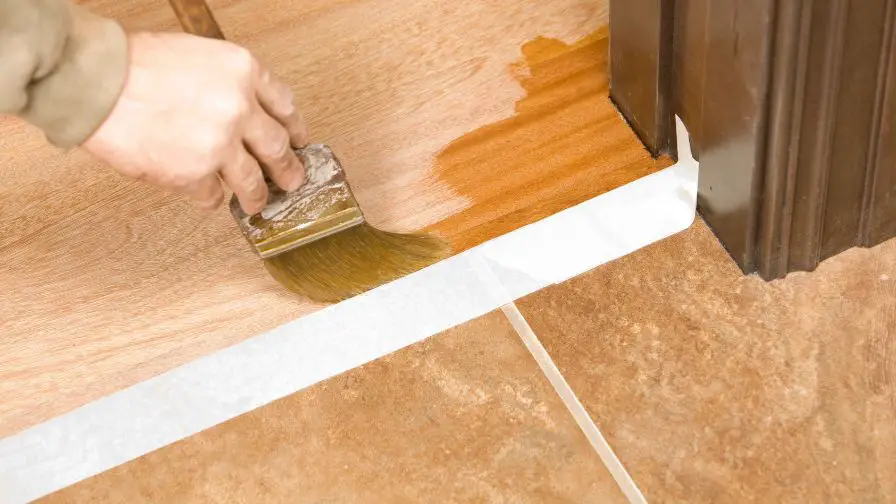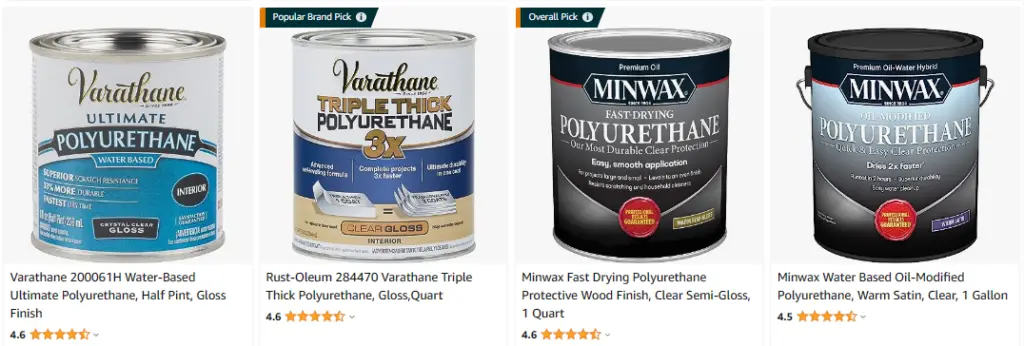
Polyurethane is a popular wood finish that many people use to protect and enhance the appearance of their wood furniture and floors. But does it change the color of the wood? The answer may surprise you!
In this blog post, we will discuss the effects of polyurethane on wood, and how to choose the right color for your needs.

Click Here To Check The Pricing On Amazon
Does Polyurethane Change The Color Of Wood?
Yes, oil-based polyurethane will change the color of the wood over time but water-based polyurethane is much thinner than oil-based, so it doesn’t build up as much on the surface of the wood. This means that it won’t change the color of your floors as dramatically as oil-based poly will. Over time, oil-based poly will still yellow slightly and lose its clarity. So if you’re looking for a polyurethane that will keep your floors looking like new, water-based is the way to go.
What Is Polyurethane And What Are Its Uses
Polyurethane is a synthetic resin that is used in many different applications. It is most commonly used as a coating for floors and furniture. Polyurethane is available in both water-based and oil-based formulas. Water-based polyurethane dries more quickly than oil-based. However, water-based polyurethane can raise the grain of the wood, so it is important to sand the surface before applying the finish. Oil-based polyurethane takes longer to dry and has a strong odor, but it provides a durable finish that resists scratches and stains. Polyurethane can be applied with a brush, a roller, or a cloth.
The benefits of using polyurethane are that it is durable, easy to apply, and provides a high-gloss finish. Polyurethane can darken the color of wood slightly, so it is important to test the finish on an inconspicuous area before applying it to the entire surface. When applying polyurethane, make sure to work in a well-ventilated area.
How To Apply Polyurethane To Your Wood Furniture Or Floors
Subscribe to Magic Bristles LLC
Polyurethane is a clear finish that protects your wood furniture or floors from scratches, stains, and water damage. You can apply it with a brush, cloth, or sponge, and it dries quickly. Polyurethane comes in different sheens, from high-gloss to satin, so you can choose the level of shine that you want. It’s important to read the label on your can of polyurethane to find out how many coats you should apply and how long it will take for each coat to dry. Follow these steps to apply polyurethane to your wood furniture or floors:
- Start by sanding your wood furniture or floors with 120-grit sandpaper to rough up the surface and remove any old finishes. If you’re working with bare wood, you’ll need to apply a stain and sealer before you begin.
- Wipe away the dust with a damp cloth and let the wood dry completely.
- Apply a thin coat of polyurethane to the surface with a brush, cloth, or sponge, working in the direction of the grain.
- Let the first coat dry completely before applying a second coat. This depends on the type of polyurethane you are using.
- Once you’ve applied the desired number of coats, let the polyurethane dry for at least 24-48 hours before using your furniture or walking on your floors. Follow the manufacturer’s instructions for the best results.
Tips For Keeping Your Wood Looking Beautiful With Polyurethane
If you’re thinking about using polyurethane to protect your wood surfaces, you might be wondering if it will change the color of the wood. The good news is that polyurethane does not usually change the color of the wood. However, there are a few things to keep in mind that can help ensure that your wood surfaces stay looking their best.
- Make sure the wood is clean before you start. Any dirt or grime on the surface of the wood will be sealed in by the polyurethane, so it’s important to make sure the surface is as clean as possible before you begin.
- You may want to test the polyurethane on a small area of the wood before you commit to doing the entire surface. This will give you a chance to see how polyurethane affects the color of the wood and decide if you like the look.
- When you’re ready to apply the polyurethane, make sure you do it in a well-ventilated area. The fumes from polyurethane can be strong, so it’s important to make sure you’re working in an area with plenty of fresh air.
- When applying polyurethane, be sure to work in thin, even coats. This will help to avoid any drips or runs in the finish.
- Once you’ve applied the polyurethane, allow it to dry completely before putting anything back on the surface. This will give the polyurethane time to cure and harden, creating a durable finish that will protect your wood for years to come.
By following these tips, you can use polyurethane to protect your wood surfaces without worrying about changing the color of the wood. Polyurethane is a great way to keep your wood looking its best for years to come.
Does Polyurethane Darken Pine Wood?
Polyurethane can be oil-based or water-based, and each type will produce a slightly different result on your pine wood.
Oil-based polyurethane will darken the color of your pinewood slightly, giving it a deep golden tone. Water-based polyurethane will not change the color of your pine wood. If you are unsure which type of polyurethane to use, always test it on a small area first to see how it will affect the color of your wood.
If you are looking to protect your pine wood without changing its color, water-based polyurethane is the best option. However, if you want to give your pine wood a deep golden tone, oil-based polyurethane is the way to go. Whichever type of polyurethane you choose, always test it on a small area first to see how it will affect the color of your wood.
Subscribe to BJBEnterprises
Does Polyurethane Bring Out Color?
No, polyurethane won’t bring out color in your wood. Water-based polyurethane will not change the color of your wood, but it will give it a slight amber tint. This is because the pigments in water-based polyurethane are transparent and they allow some of the wood’s natural color to show through. If you want to keep the true color of your wood, water-based polyurethane is the way to go.
Oil-based polyurethane will create a yellow or amber hue, especially in light colors. This is because the pigments in oil-based polyurethane are not as transparent as those in water-based polyurethane. If you’re looking to change the color of your wood, oil-based polyurethane is a good option. Just be aware that it may take several coats to achieve the desired effect.
Does Water-Based Polyurethane Change Wood Color
Water-based polyurethane does not change the color of the wood. It is clear and will protect the wood without changing its natural color. You can apply multiple coats to build up a thicker protective layer, but it will remain transparent.
If you want to change the color of your wood floors, using water-based polyurethane is not the way to do it. You would need to use a stain or paint first, and then seal it with polyurethane. This would give you the color change you’re looking for.



